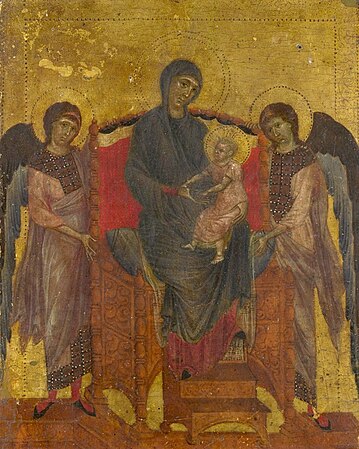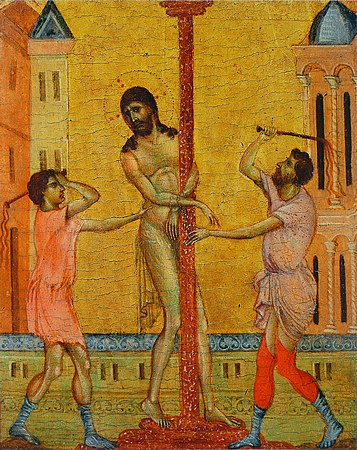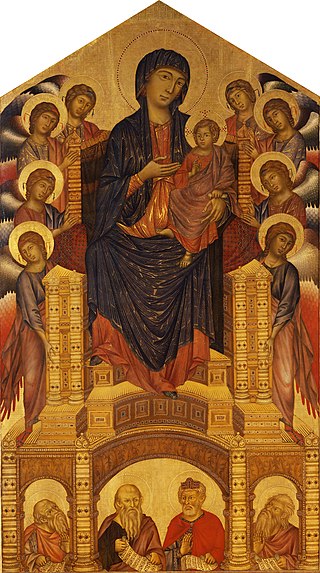
Cimabue, also known as Cenni di Pepo or Cenni di Pepi, was an Italian painter and designer of mosaics from Florence.

An altarpiece is an artwork such as a painting, sculpture or relief representing a religious subject made for placing at the back of or behind the altar of a Christian church. Though most commonly used for a single work of art such as a painting or sculpture, or a set of them, the word can also be used of the whole ensemble behind an altar, otherwise known as a reredos, including what is often an elaborate frame for the central image or images. Altarpieces were one of the most important products of Christian art especially from the late Middle Ages to the era of the Counter-Reformation.

A triptych is a work of art that is divided into three sections, or three carved panels that are hinged together and can be folded shut or displayed open. It is therefore a type of polyptych, the term for all multi-panel works. The middle panel is typically the largest and it is flanked by two smaller related works, although there are triptychs of equal-sized panels. The form can also be used for pendant jewelry.

A polyptych is a painting which is divided into sections, or panels. Specifically, a "diptych" is a two-part work of art; a "triptych" is a three-part work; a tetraptych or quadriptych has four parts, whereas a polyptych describes any work of art formed of more than one constitutive part.

Water Lilies is a series of approximately 250 oil paintings by French Impressionist Claude Monet (1840–1926). The paintings depict his flower garden at his home in Giverny, and were the main focus of his artistic production during the last thirty years of his life. Many of the works were painted while Monet suffered from cataracts.

Saint Francis Receiving the Stigmata is a panel painting in tempera by the Italian artist Giotto, painted around 1295–1300 for the Church of Saint Francis in Pisa and it is now in the Musée du Louvre in Paris. It shows an episode from the life of Saint Francis of Assisi, and is 314 cm high by 162 cm wide. It is signed OPUS IOCTI FLORENTINI.
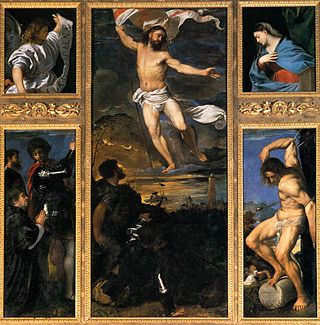
The Averoldi Polyptych, also known as the Averoldi Altarpiece, is a painting by the Italian Renaissance painter Titian, dating to 1520–1522, in the basilica church of Santi Nazaro e Celso in Brescia, northern Italy.

Crucifixion Diptych — also known as Philadelphia Diptych, Calvary Diptych, Christ on the Cross with the Virgin and St. John, or The Crucifixion with the Virgin and Saint John the Evangelist Mourning — is a diptych by the Early Netherlandish artist Rogier van der Weyden, completed c. 1460, today in the Philadelphia Museum of Art. The panels are noted for their technical skill, visceral impact and for possessing a physicality and directness unusual for Netherlandish art of the time. The Philadelphia Museum of Art describes work as the "greatest Old Master painting in the Museum."

Salvator Mundi is a painting attributed in whole or in part to the Italian High Renaissance artist Leonardo da Vinci, dated to c. 1499–1510. Long thought to be a copy of a lost original veiled with overpainting, it was rediscovered, restored, and included in a major exhibition of Leonardo's work at the National Gallery, London, in 2011–2012. Auction house Christie's stated just after selling the work in 2017 that most leading scholars consider it to be an original work by Leonardo, but this attribution has been disputed by other leading specialists, some of whom propose that he only contributed certain elements; and others who believe that the extensive damage prevents a definitive attribution.

The Crucifixion and Last Judgement diptych consists of two small painted panels attributed to the Early Netherlandish artist Jan van Eyck, with areas finished by unidentified followers or members of his workshop. This diptych is one of the early Northern Renaissance oil-on-panel masterpieces, renowned for its unusually complex and highly detailed iconography, and for the technical skill evident in its completion. It was executed in a miniature format; the panels are just 56.5 cm (22.2 in) high by 19.7 cm (7.8 in) wide. The diptych was probably commissioned for private devotion.

Christ Bearing the Cross is a tempera painting attributed to Nikolaos Tzafouris. Nikolaos Tzafouris was a Greek painter. He is one of the founding members of the Cretan School along with Andreas Ritzos, Andreas Pavias, and Angelos Akotantos. He was influenced by Angelos Akotantos. According to the Institute of Neohellenic Research, thirteen paintings are attributed to Tzafouris. Tzafouris was active between 1480 and 1501. Tzafouris had a workshop in Heraklion. Tzafouris painted religious themes for local churches. The painting is a mixture of Italian and Greek Byzantine prototypes. The work followed the traditional maniera greca and was influenced by Venetian painting. His most notable works are the Madre della Consolazione and Christ Bearing the Cross. Christ Bearing the Cross is in Manhattan on display at Metropolitan Museum of Art.

Le Palais Ducal or The Doge's Palace is the name given to various oil paintings which depict the Doge's Palace made by Claude Monet during a visit to Venice in 1908.
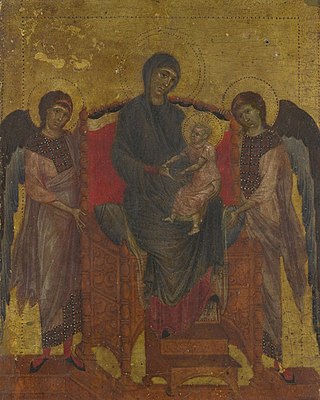
Virgin and Child with Two Angels is a panel painting by 13th-century Italian artist Cimabue, in egg tempera on a poplar panel, dated to c. 1280. It has been held by the National Gallery in London since 2000.

The Flagellation of Christ is a panel painting by 13th-century Italian artist Cimabue, in egg tempera and gold leaf on a poplar panel, dated to c.1280. It has been held by the Frick Collection in New York since 1950, and is the only painting by Cimabue in the US. The Frick Collection acquired the painting from the Knoedler gallery in Paris in 1950. Previously, it had been owned by the antiques dealer M Rolla at the end of the 19th century, inherited by G Rolla, and then sold to the art dealer Eduardo Moratilla.

The Diptych of Devotion was a small tempera and gold on poplar panel altarpiece painted in the 1280s by Cimabue. It is thought to have originally consisted of two panels, each with four scenes from the life and passion of Jesus. These are thought to have been split up for the art market in the 19th century.
The Life of Christ is a series of five paintings in tempera and gold on panel depicting scenes from the Life of Christ and the Last Judgement. The works date to around 1290–1300 and are attributed to the circle of Cimabue or to a Venetian artist. They are now in various museums and private collections: the Longhi Foundation in Florence, the New Orleans Museum of Art, the Portland Art Museum, the Pedralbes Monastery near Barcelona and a private collection in Milan.

Georgios Kalliergis or Kallergis was a Byzantine Greek painter. He is one of the few Greek painters of the Byzantine empire known by name. Other Byzantine painters include: Theodore Apsevdis, Kokkinobaphos Master, and Ioannis Pagomenos. Kalliergis was one of the masters of Thessaloniki. He was part of the Macedonian School of painting. His last name Kallergis was associated with a noble family from the island of Crete. Two other very famous Greek painters Nikolaos Kallergis and Christodoulos Kalergis shared the same last name. Georgios was associated with Mount Athos, Veria, and Thessaloniki. His most notable frescos are in the Church of the Resurrection of Christ in Veria, Greece.
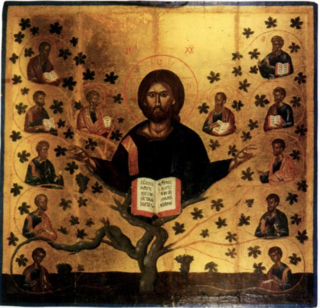
Christ the Vine is a tempera painting created by Greek painter Angelos. Angelos was active from 1425 to 1457. He was a teacher and protopsaltis. His students included some of the most famous painters of the early Cretan Renaissance. Andreas Pavias and Andreas Ritzos were his students and were heavily influenced by his style. Forty-nine of his works survived. Angelo’s Christ the Vine was one of his most important works.

The Man of Sorrows is a tempera and oil on panel painting of Jesus Christ by the Florentine artist Sandro Botticelli (1445-1510), thought to have been painted sometime between 1500 and 1510.

